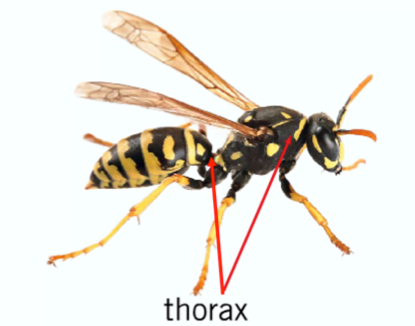In insects, the thorax is the core body portion that controls movement. It is divided into three sections. Each segment has two legs, with varied adaptations such as running (cursorial), jumping (saltatorial), or swimming (natatorial) depending on the insect’s needs. Winged insects have two sets of wings with venation patterns that serve as structural support. Wings can be modified in a variety of ways, such as protective elytra in beetles, leathery tegmina in grasshoppers, and balancing halteres in flies, allowing insects to adapt to different surroundings and lifestyles.
Table of Contents
Thorax in Insects: Overview
The thorax is the middle part of an insect’s body, located between the head and abdomen. It is essential for movement because it supports the wings and legs. It is separated into three sections:

Segmentation
- Prothorax: The anterior (front) segment is typically smaller in size. It normally carries the first pair of legs.
- Mesothorax: The middle segment, which is often bigger, connects the first pair of wings with the second pair of legs.
- Metathorax: The rear segment typically houses the second pair of wings and the third pair of legs.
Structure
- It is primarily composed up of tough plates known as sclerites, which create a protective exoskeleton.
- Dorsal Plate (Tergite): Covers the top part it.
- Ventral Plate (Sternite): Covers the underside.
- Lateral Plates (Pleurites): Protect the sides of the thorax.
The thoracic musculature is substantially developed, particularly in flying insects, to support leg and wing movement.
Legs and Their Modifications
Insects usually have three pairs of legs linked to each segment. An insect leg is made up of the following parts:
- Coxa: The base section connects the leg to the body.
- Trochanter: A small joint that links the coxa and femur.
- Femur: The lengthy, thick portion used for strength.
- Tibia: A thin section that follows the femur.
- Tarsus: The foot-like structure is composed of numerous tiny pieces.
- Pretarsus: Claws are frequently found at the terminal part.
Common Modifications of Insect Legs:
- Cursorial Legs (designed for running): e.g., cockroaches.
- Saltatorial Legs (adapted for jumping): e.g., grasshoppers and crickets.
- Raptorial legs (designed for grasping prey): e.g., praying mantis.
- Natatorial Legs (Adapted for Swimming): e.g., water beetles.
- Fossorial Legs (suitable for digging): e.g., mole crickets.
Wing Venation
Insects with wings often have two pairs (one linked to the mesothorax and the other to the metathorax. Wing venation is the arrangement of veins in the wings that give structural support while also housing nerves, hemolymph, and, in some cases, tracheae.
Main veins in insect wings:
- Costa (C): The leading edge vein.
- Subcosta (sc): A vein that provides support behind the costa.
- Radius (r): A powerful vein that frequently branches.
- Media (m): Positioned following the radius.
- Cubitus (Cu): Frequently divides into two large branches.
- Anal Vein (A): Located on the back margin of the wing.
Insect identification and classification rely heavily on wing venation patterns.
Wings and Their Modifications
Wings are one of the most distinctive characteristics of insects, yet some are secondarily wingless. The membrane and venation make up the basic structure of insect wings, with some groups having thickened or modified wings.
Types of Wing Modifications:
- Tegmina: Leathery forewings, found in grasshoppers and crickets, provide protection for the hind wings.
- Elytra: Beetles (Coleoptera) have hard, protecting forewings that shield their delicate hindwings.
- Halteres: Flies (Diptera) have reduced hindwings, which serve as balancing organs during flying.
- Hemi-elytra: Some true bugs (Hemiptera) have forewings that are partly thickened at the base and membranous at the tips.
- Fringed wings: Found in microscopic insects such as thrips, which have wings covered in fine hairs to aid in flight.
To summarize, the insect thorax serves multiple functions, including supporting the legs and wings and enabling locomotion. Insect adaptations, such as changes to their legs and wings, allow them to live in a variety of ecological niches.
Frequently Asked Questions
What are the three segments of the insect thorax?
The insect’s thorax is separated into three segments.
Prothorax: Has the first pair of legs.
Mesothorax: Has the second pair of legs and the first pair of wings.
Metathorax: Has the third pair of legs and the second pair of wings.
What is the main function of the thorax in insects?
The thorax primarily facilitates movement by supporting the wings and legs, making it necessary for locomotion whether walking, flying, jumping, or swimming.
Related Articles

